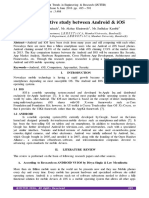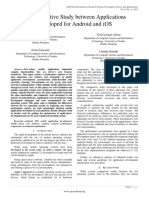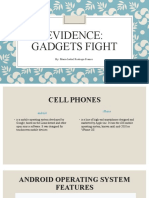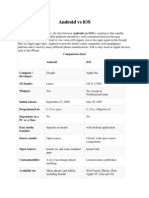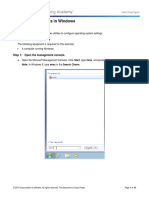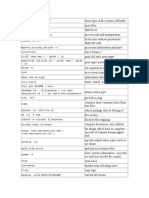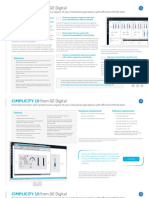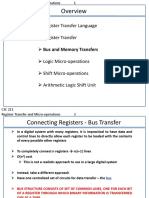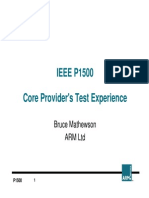1
Android and iOS Comparison
Student Name
University
Course
Professor Name
Date
� 2
Introduction
The mobile technology improvement serves as a crucial stage in the technological
advancement. Mobile technology offers individuals and organizations benefits like real-time data
sharing, effective communication, remote collaboration, and enhanced internet usage (Gyorödi et
al., 2017). Android and iOS are currently the most popular and reliable mobile operating
systems. Google released Android OS in 2008 while Apple launched iOS in 2007 to support
mobile applications. In this case, evaluating Android and iOS features from both a user and
developer’s perspective can enable a company to make an informed decision.
Mobile App versus Website
Users can access websites and applications using mobile devices like tablets and
smartphones. A mobile website comprises interconnected browser-based HTML pages that are
accessible on the internet. The website category utilizes designs that promote their compatibility
with touch-screen interfaces and handheld displays. These websites can display data, video,
images, and text content like other websites. On the contrary, mobile applications are
downloadable software that functions within devices instead of browsers (Cunningham, 2023).
For instance, Android and iOS device users can download apps from the Google Play Store and
Apple App Store, respectively.
System Mobile Functionalities
Exclusive features for iOS devices are Breezy setup, AirDrop, App offloading, iMessage,
and WiFi password sharing. Android and iOS provide widgets to improve accessibility to crucial
functionalities and data in tablets and smartphones. The Android OS provides high
customizability to facilitate the development of feasible software based on specific users’ needs.
� 3
Conversely, exclusive features of Android include file management, guest accounts, a
customizable home screen, expandable storage, and a split screen (Cunningham, 2023). Unlike
Android, iOS has limited customizability unless developers implement jailbreaking techniques to
remove particular restrictions (Ahmad et al., 2013). Markedly, file transfer in iOS-powered
smartphones is a difficult procedure that depends on applications like Finder and iTunes.
Additionally, Android utilizes an open-source model while iOS utilizes a closed-source OS
model.
Mobile Interfaces
Android and iOS utilize touch interfaces that support operations like pinch-and-zoom,
tapping, and swiping. User interfaces for both operating systems have a status bar that provides
information like battery life, cell and WiFi signal, and time. Android provides a status bar that
displays additional information like reminders, messages, and new text messages (Wukkadada &
Nambiar, 2015). Nonetheless, these operating systems provide different interface features on
their respective mobile devices. For instance, the iOS interface provides a dock function that
enables users to pin the most regularly utilized applications on their mobile gadgets. Additional
user interface features in the iOS 14 version are pinned chats, exposure lock, picture-in-picture,
custom widget stack, and third-party default apps. On the contrary, Android 11 has interface
features like improved media controls, one-time permissions, native screen recording, and
priority conversations.
Application Development Myths
App development requires developers to debunk application development myths.
Developers should debunk the myth about the inexpensive and ease of mobile application
� 4
development. Existing evidence proves that mobile application development occurs at a similarly
high cost and intricate procedure to the desktop application. Professionals should ignore the
assumption that app development is only limited to coding since additional procedures are
involved. An assumption that a single app is compatible with all platforms is false (McWherter &
Gowell, 2012). Individuals should understand that applications can be customized for specific
operating systems. People should also not assume that mobile applications are developed
exclusively for smartphones. Rather, individuals should understand that mobile applications are
utilized in smart devices (refrigerators and TVs) and tablets.
Adaptive vs. Dedicated Mobile Websites
Today, web designers consider that mobile usage in accessing website content has
increased tremendously. The situation necessitates the design of mobile-friendly websites,
namely adaptive and responsive websites. Responsive mobile websites feature designs that
facilitate their shrinkage and expansion based on the screen size. The fluid design associated with
this website offers benefits like fast development rates, low maintenance, and flexibility
(Moebert et al., 2016). The Responsive design facilitates the development of websites that can be
utilized simultaneously on computers and mobile devices. Conversely, adaptive design facilitates
the design of separate websites for desktops, mobile screens, and tablets. Unfortunately, this
website design has limitations like high maintenance requirements, longer development times,
and user inconveniences.
Conclusion
Security is a crucial factor that developers and users should consider when choosing
between iOS and Android devices. Android device usage exposes users to cyberattack threats due
� 5
to security update challenges related to manufacturers' laxity. Latest Android-powered devices
provide biometric authentication features like face and fingerprint scanners to prevent
unauthorized access. On the other hand, Apple device users rarely face security threats since iOS
offers occasional security updates and highly controlled app downloads. Biometric authentication
features like face and fingerprint scanners are also available on iOS devices like iPhones and
iPads. Therefore, iOS is the most desirable operating system for usage in companies due to its
security aspect.
� 6
References
Ahmad, M. S., Musa, N. E., Nadarajah, R., Hassan, R., & Othman, N. E. (2013, July).
Comparison between android and iOS Operating System in terms of security. In 2013 8th
International Conference on Information Technology in Asia (CITA) (pp. 1-4). IEEE.
https://doi: 10.1109/CITA.2013.6637558
Cunningham, A. (2023). iPhone vs. Android: Which Is Better for You? Wirecutter.
https://www.nytimes.com/wirecutter/reviews/ios-vs-android/
Gyorödi, R., Zmaranda, D., Adrian, V. G., & Gyorödi, C. (2017). A comparative study between
applications developed for Android and iOS. International Journal of Advanced
Computer Science and Applications, 8(11).
McWherter, J., & Gowell, S. (2012). Professional mobile application development. Hoboken:
John Wiley & Sons.
Moebert, T., Zender, R., & Lucke, U. (2016). A generalized approach for context-aware
adaptation in mobile e-learning settings. Mobile, Ubiquitous, and Pervasive Learning:
Fundaments, Applications, and Trends, 23-53. https://doi.org/10.1007/978-3-319-26518-
6_2
Wukkadada, B., Nambiar, R., & Nair, A. (2015). Mobile operating system: Analysis and
comparison of Android and iOS. International Journal of Computing and Technology,
2(7), 273-276. https://citeseerx.ist.psu.edu/document?
repid=rep1&type=pdf&doi=101f723d06082a6c06d327077607aded1e5c7a56
�7



